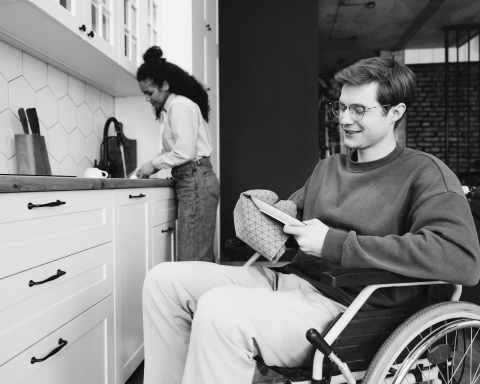People with motor limitations often feel restricted in carrying out daily activities and generally live most of their lives in a wheelchair. However, they cannot perform most activities because their movement is limited.
Environmental conditions greatly influence the freedom of wheelchair users to carry out their activities. Poorly organized space will certainly make it increasingly difficult for them to carry out activities independently. If this is left unchecked, it will slowly cause stress in wheelchair users.
An adapted home for the disabled must provide environmental conditions that support freedom of movement and provide residents with a sense of security and comfort. This article will invite readers to learn in-depth about organizing a home into a friendly and accessible environment for wheelchair users.
Adapting the kitchen for accessibility
The kitchen is a very important location for the occupants of the house as a place to prepare food. Modifying several parts of the kitchen is the right step in an effort to create a kitchen that is easily accessible for wheelchair users.
Accessible countertops and cabinets
For wheelchair users, it’s crucial to have lower countertops in the kitchen that provide space for their knees underneath. Consider installing countertops at a height of 32 inches. It’s always important to double-check these measurements with the person using them.
Lower countertops will result in shorter cabinets, so it will be easier for wheelchair users to reach stuff in cabinets. Also, providing lower countertops with footrests could make them feel comfortable while doing their activities in the kitchen.
Installing shelves with drawers
Shelves with drawers are one of the recommended choices for storage options in the kitchen. Just like countertops, the height of the shelves should be adjusted to suit wheelchair users, so they can reach them easily. Having drawers on the shelves can also make it easier to store items because they can simply pull the drawer to get the items they need.
Choosing accessible appliances
Installation of other equipment, such as sinks and electrical access, must be carried out by taking into account the distance that can be accessed by wheelchair users in a sitting position. The height of the sink must be adjusted to provide room for the wheelchair user’s knees underneath. Then, the drain pipe must be installed towards the back of the sink and equipped with a protective cover to reduce contact with feet.
Electrical access such as switches and sockets, apart from having to be installed at an accessible height, should not be installed in a corner because it will make it more difficult for wheelchair users to access them. Both should also not be placed behind other furniture or doors.
Choosing wheelchair-friendly furniture
Selection of furniture to provide a wheelchair-friendly home must be made, taking into account ease of access and use. Try to prioritize functionality and accessibility in the process.
Adjustable-height tables
Adjustable-height furniture is really needed for wheelchair users when carrying out their activities, such as studying or working, and other activities that require a table. Adjustable-height desk allows wheelchair users to adjust the desk height according to their needs. This can also minimize the risk of measurement errors when using a table with a fixed height, as used by people in general.
Furniture with casters
Some furniture — such as tables, chairs, shelves, and containers — allow it to be used in several rooms. However, moving furniture from one room to another will certainly make it difficult for wheelchair users. Therefore, the solution that can be taken is to try to choose furniture that is equipped with casters. This can facilitate the process of moving furniture because wheelchair users only need to push the furniture to be moved to the desired place.
Apart from that, opt for sliding doors instead of swinging ones. Using a swinging door makes it difficult for wheelchair users because it requires back-and-forth movement. Therefore, using a sliding door can be considered because it is convenient for wheelchair users.
Wheelchair-accessible bathroom
Bathrooms generally have narrow spaces and slippery surfaces. This can be a challenge for wheelchair users because the narrow space will make it difficult for them to maneuver. Additionally, slippery surfaces can increase the risk of falls and injury. Therefore, several modifications are needed to create a bathroom that is safe for wheelchair users.
Adding circulation space
There is no set size for all parts of the bathroom, so it can be said to be wheelchair-friendly. However, adding a circulation area in the bathroom can make it easier for wheelchair users to maneuver in the narrow space. Estimate to provide a space measuring 1500mm x 1500mm as a circulation area in the bathroom.
Slip-resistant flooring
Slippery bathroom floor surfaces can be problematic for wheelchair users because they can increase the risk of falls and injury. Therefore, consider choosing a flooring product with a slip-resistant label based on laboratory test results.
Installing safety bars
Another tool that can be used to support the movement of wheelchair users in the bathroom is by adding safety bars on the walls. Safety bars can facilitate wheelchair users to hold on so they don’t fall if they are faced with a situation that requires them to move from a wheelchair, for example, to sit on the toilet.
Adding a shower bench
Wheelchair users generally cannot shower like ordinary people in bathrooms without adequate facilities. Therefore, having a shower bench is one of the easy and affordable ways that can be done. Shower benches allow wheelchair users to shower without having to force their legs to stand.
Accessible outdoor access
Many people think that wheelchair users do not need access outside because they must always be inside the house to avoid the risk of accidents. In fact, the difficulty of getting out of the house actually makes wheelchair users feel helpless and can cause stress. Creating a home that is friendly for wheelchair users must be done from the inside and outside areas. Therefore, easy access to the outdoors, either through doors or windows — to see the view from inside the house — is something that needs to be considered.
Installing ramps as pathways
Ramps are facilities that replace stairs and can be used by wheelchair users to access rooms at different levels, both inside and outside the house. Installing ramps requires a lot of space, so ramps are generally more effective to be used outside as an entrance from the yard to the house.
Widening the doorways
Wheelchair users need wider doorways than the average person. Widening the doorways can be done as an effort to minimize the risk of collisions between the door frame and body parts or wheelchairs. The recommended doorway width is 1000 mm to facilitate one-way wheelchair movement.
Accessible windows
Apart from being a doorway for fresh air, windows also provide access for individuals to see the outside view from inside the house. For wheelchair users, the presence of accessible windows can support their psychological well-being because it allows them to see outside the house, thereby minimizing feelings of isolation.
It is recommended to install windows no higher than 800mm from the floor level to make it easier for wheelchair users to enjoy the outside view and open and close windows. Using lever handles rather than knobs for access to window openers is recommended to avoid access using both hands.
Storage and organization ideas
Wheelchair users mainly need more storage space than people in general to store medical supplies, which are usually large and numerous. This storage space must be adjusted to the size of the room and the equipment to be stored in it. Apart from that, it is important to keep the storage space clean and not used to store other items, such as kitchen supplies.
Also, consider adding dedicated wheelchair storage space and transfer areas. Typically, wheelchair users have more than one wheelchair to use in different places. For example, an electric wheelchair is used outdoors, while a manual wheelchair is used inside the house. Therefore, providing a wheelchair storage room and transfer area close to the main entrance can ensure that dirt that sticks to electric wheelchairs is not brought into the house.
Apart from considering storage space, also declutter regularly to keep the hallways in the house clean and organized. The cleanliness of the aisle is very important for maneuvering wheelchair users so they don’t get stuck or fall due to scattered objects.
In conclusion
Making modifications to create a wheelchair-friendly home requires a lot of consideration. The most important consideration that must be remembered is room modifications must be adapted to the needs of the occupants concerned. These individuals will carry out their daily activities at home using their wheelchairs.
The ability to perform tasks autonomously while in a wheelchair instills in them a sense of empowerment. Designing a secure and welcoming living environment for individuals who use wheelchairs doesn’t just improve their physical mobility. It also positively affects their emotional and mental health.
If you would like to see more resources on organizing for wheelchair users, check out the Home Organization Science Labs. The lab uses the research of the Institute for Life Management Science to produce courses, certifications, podcasts, videos, and other tools. Visit the Home Organization Science Labs today.
Photo by ASphotofamily on Freepik



